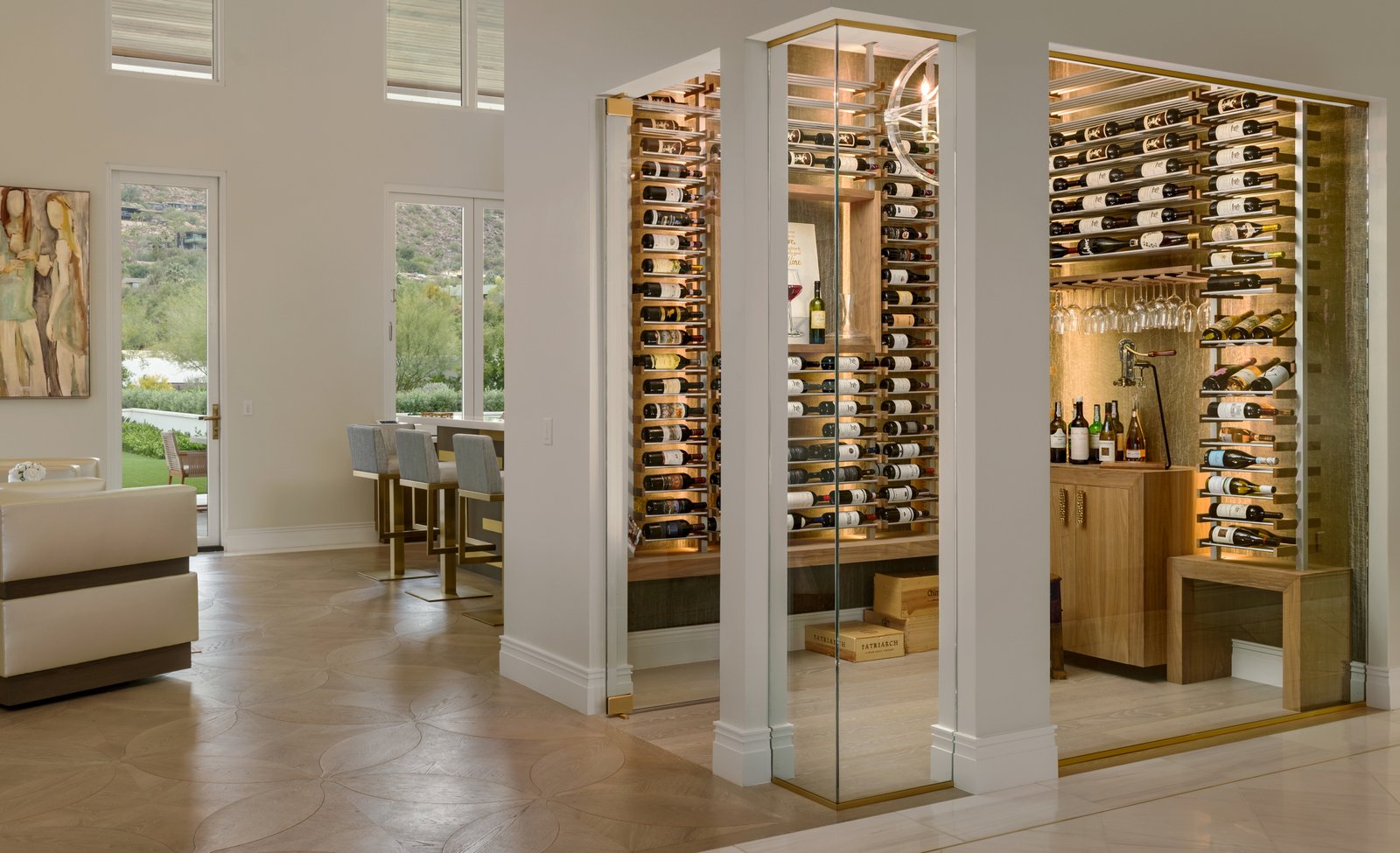Balancing Function and Style in Indonesian Kitchen Design
The significance of proper kitchen cabinet dimensions must be balanced in kitchen cabinets design. It’s a delicate dance, ensuring every inch is utilized effectively without compromising the room’s overall flow and aesthetics. This becomes even more critical in Indonesia, where home designs range from compact urban apartments to expansive traditional dwellings. The correct kitchen cabinet dimensions can transform a kitchen from a functional area into a heartwarming space that radiates comfort and style.
The aesthetics of Indonesian homes are as diverse as their rich cultural tapestry. From the intricate woodwork typical of Balinese architecture to the sleek, modern lines favored in metropolitan Jakarta, kitchen cabinets must fit the space and complement these varied aesthetics. This requires thoughtful consideration of size and design, ensuring cabinets are manageable in smaller areas yet sufficiently accommodating in larger ones.
In essence, the kitchen cabinet dimensions in Indonesian kitchens are more than just a practical element; they are a pivotal aspect that bridges functionality with the unique charm and character of Indonesian home design. Balancing these dimensions with each home’s spatial constraints and aesthetic ethos is crucial to creating efficient and visually appealing kitchens.
Understanding Standard Kitchen Cabinet Dimensions
Regarding kitchen cabinets, a few standard dimensions are generally adhered to worldwide, and these serve as a valuable guide for both homeowners and designers. In Indonesian kitchens, where functionality and style are paramount, understanding these standards is the first step to creating a harmonious space.
Base Cabinets: The workhorses of the kitchen, base cabinets typically stand at about 85–90 cm in height, a comfortable level for most adults to work at without bending over. They usually have a depth of 55–60 cm, providing ample space for countertops and kitchen appliances. In Indonesian homes, where cooking often involves a variety of devices and large pots, this depth is particularly beneficial.
Wall Cabinets: These are mounted above the base cabinets and can vary in height. Standard dimensions are 30–40 cm in depth, allowing for accessibility and ensuring that items are within easy reach. The size can vary depending on the ceiling height and personal preference. However, maximizing vertical space is crucial in many Indonesian homes due to more compact living rooms.
Tall Cabinets: Often used as pantry space or to house larger appliances like ovens, these cabinets can reach 210 cm in height. They’re typically about 55–60 cm deep. In Indonesian kitchens, tall cabinets are valuable for maximizing storage in a relatively small footprint, a common scenario in urban homes.
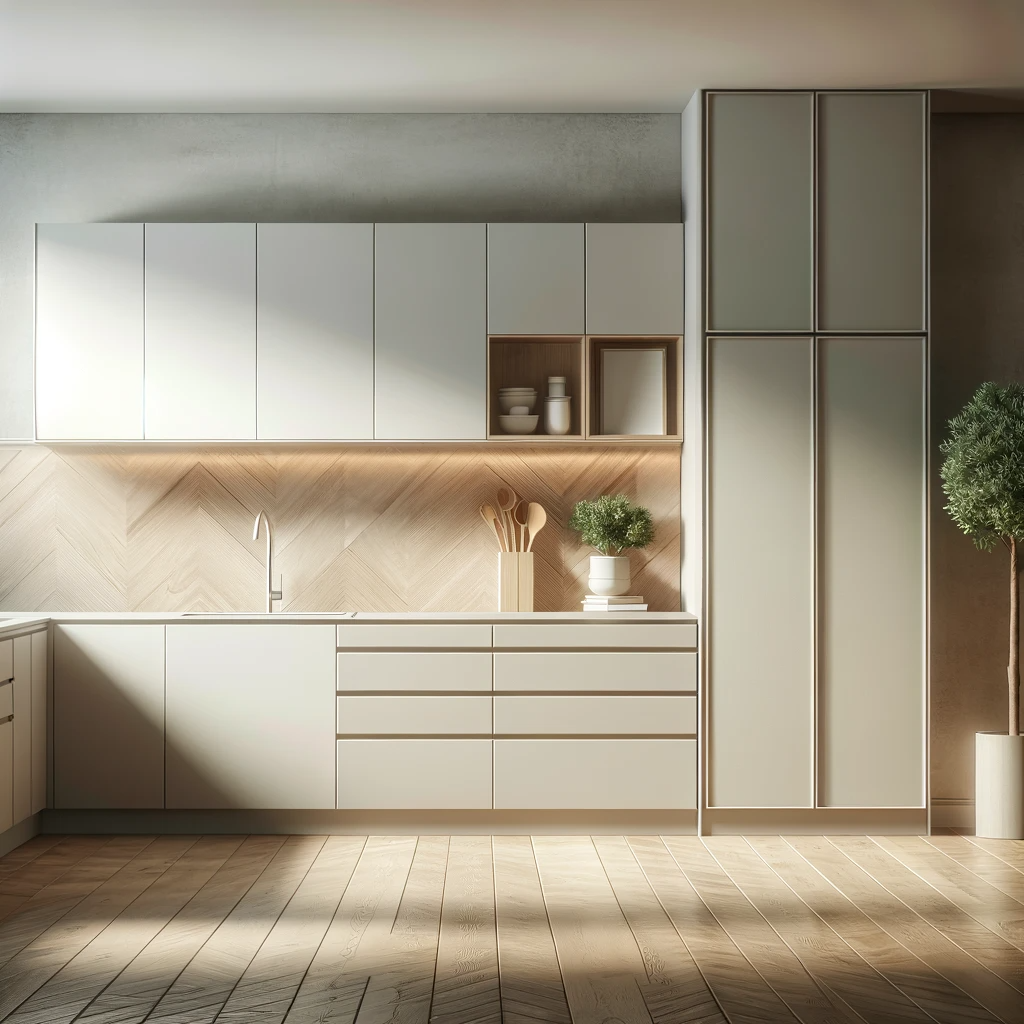
The image displayed a kitchen with base cabinets on the lower left, wall cabinets on the upper left, and a tall cabinet on the right.
Applying these standard dimensions to Indonesian kitchens requires blending these global standards with local considerations. For instance, the cabinets’ depth and height might be more flexible in a traditional Indonesian home, where the kitchen might be more significant and open. In contrast, in a high-rise apartment in Jakarta, efficient use of space might dictate taller and more slender cabinets.
The Importance of Custom Cabinetry
Custom cabinetry is a game-changer in kitchen design, especially in the diverse settings of Indonesian homes. It’s not just about aesthetics; it’s about crafting spaces that genuinely resonate with the homeowner’s lifestyle and the unique architectural character of their home.The one-size-fits-all approach doesn’t quite cut it in Indonesia, where homes can range from sprawling traditional houses to modern, space-constrained apartments. Custom cabinetry allows for creating solutions that perfectly fit the available space. This means every inch is utilized efficiently, whether in a narrow galley kitchen in a high-rise or a spacious, open-plan traditional home.
Adapting Standard Dimensions for Typical Indonesian Home Layouts
Space can be a premium in urban Indonesian homes, particularly in Jakarta or Surabaya. Standard kitchen cabinet dimensions need to be adapted to fit smaller kitchen spaces. This could mean designing slimmer base cabinets or incorporating taller wall cabinets to make the most of vertical space. For instance, in a compact kitchen, full-height pantry cabinets can provide ample storage without occupying too much floor space.
Conversely, in more spacious, traditional homes, such as those in rural areas or places like Bali, there’s more room to play with kitchen cabinet dimensions. Larger kitchens can accommodate broader and deeper cabinets, allowing for more generous storage and workspace areas. Here, the customization can enhance the aesthetic appeal and integrate traditional Indonesian craftsmanship.
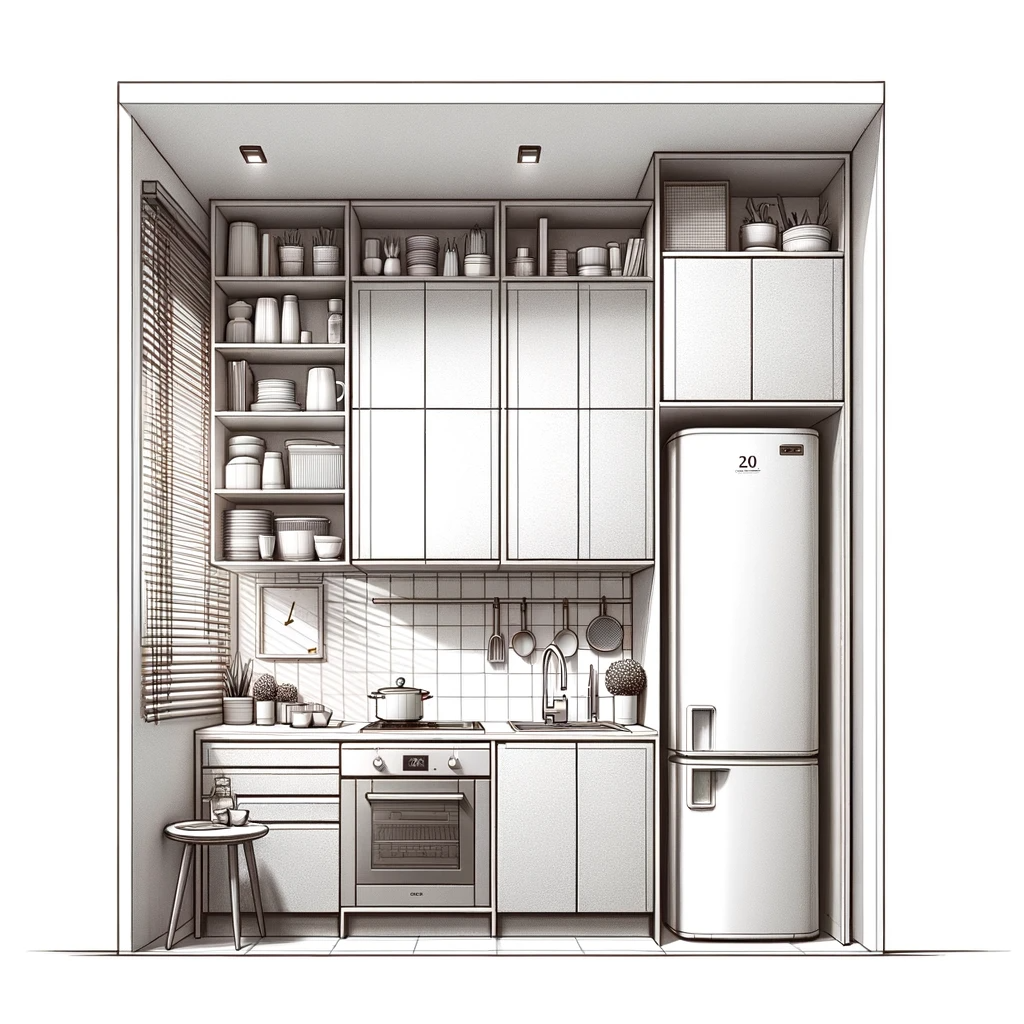
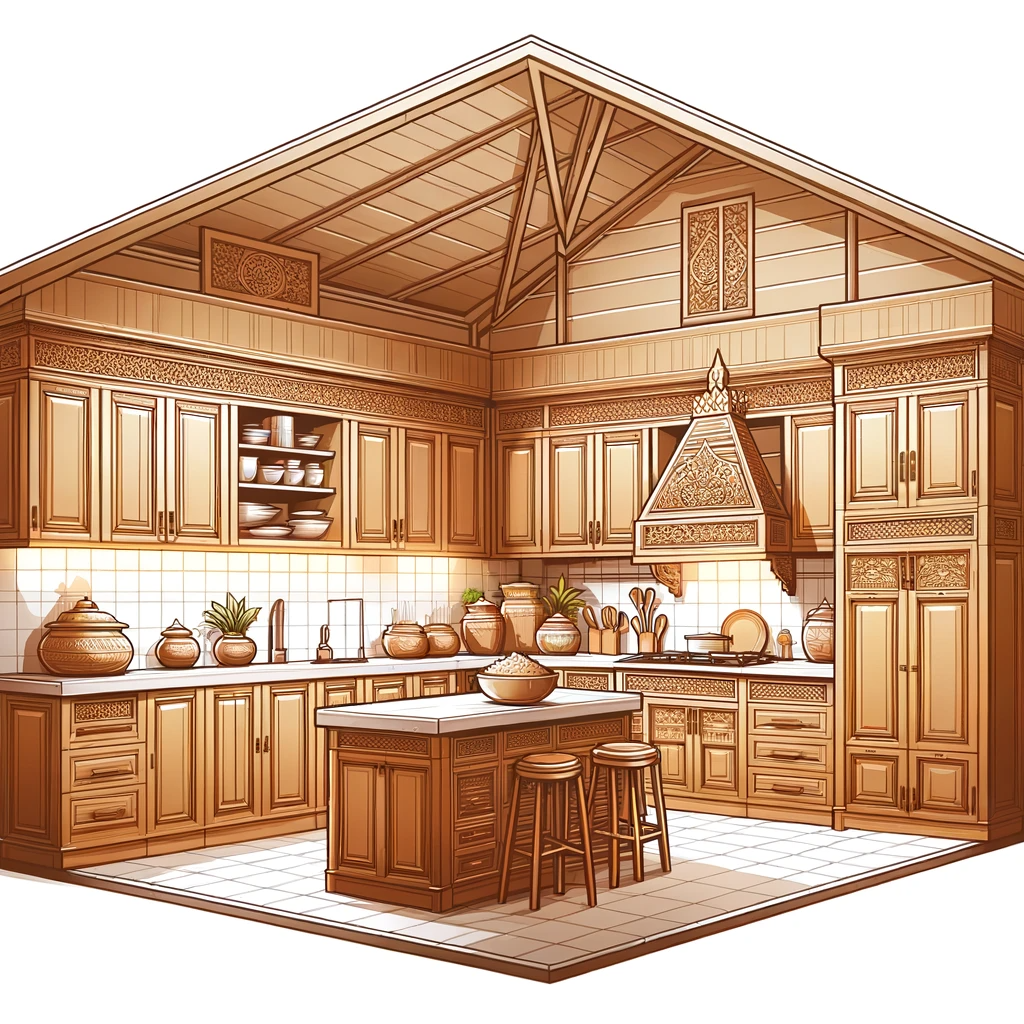
Maximizing Space in Small Kitchens
Optimizing kitchen space in smaller Indonesian homes requires intelligent and creative approaches to cabinetry. When every square centimeter counts, the design and placement of cabinets can significantly affect functionality and aesthetics.
Tips for Optimizing Kitchen Cabinet Dimensions in Smaller Indonesian Kitchens:
- Go Vertical: Utilize the vertical space in your kitchen. Opt for taller cabinets that reach up to the ceiling. This provides more storage and draws the eye upwards, making the kitchen appear more prominent.
- Slim Down: Consider slimmer base cabinets to free up more floor space. This can make the kitchen feel less cramped and more open while providing ample storage.
- Corner Solutions: Use tricky corner spaces with innovative corner cabinets. Options like lazy Susans or pull-out corner units can maximize this often-wasted space.
- Open Shelving: Incorporate open shelves where feasible. They can relax the space and store frequently used items or decorative pieces.
- Integrated Appliances: Opt for cabinets that house appliances, such as built-in ovens or under-counter fridges. This creates a seamless look and saves valuable space.
Creative Solutions for Storage and Functionality in Limited Spaces:
- Pull-out Pantries: Narrow, vertical pull-out cabinets are perfect for storing spices, condiments, and other small items. They utilize minimal space while offering convenient access.
- Hanging Storage: Use the underside of wall cabinets to hang items like mugs, utensils, or dish towels. This frees up cabinet space for other things.
- Multi-functional Islands: A small kitchen island can provide extra counter space and storage if space allows. Opt for a mobile island for added flexibility.
- Door Organizers: Utilize the inside cabinet doors with organizers for lids, chopping boards, or cleaning supplies.
- Foldable Features: Incorporate foldable or pull-out counters that can be used as additional prep space and tucked away when unused.
Choosing Materials and Finishes
- Lighter Finishes: Light-colored woods or laminates can make a small kitchen feel more open and airy. Glossy finishes can reflect light, contributing to a sense of spaciousness.
- Texture and Color: While stylish, dark tones and textured finishes can make a space feel smaller. These can add depth and character in larger kitchens without overwhelming the space.
- Glass Elements: Using glass-front cabinet doors can create a sense of depth and openness, which is ideal for smaller kitchens.
Recommendations for Materials Suitable for the Indonesian Climate and Style:
- Laminates and veneers: For a more cost-effective option, laminates and veneers can offer the look of natural wood with added humidity resistance and easier maintenance.
- Metal and Glass: In modern Indonesian homes, incorporating metal and glass can add a contemporary touch. Stainless steel, for instance, is durable and easy to clean.
- Stone Countertops: Granite or engineered quartz are excellent options for countertops due to their durability and resistance to heat and scratches.
Adding to the previous section on choosing materials and finishes for kitchen cabinets in Indonesia, an important consideration is the local cuisine. Indonesian food is known for its vibrant colors, which can sometimes pose a challenge regarding stains and maintenance.

Given the nature of Indonesian cooking, which often includes turmeric, chili, and other colorful spices, selecting materials that are easy to clean and less prone to staining is crucial. Here are some additional recommendations:
Materials Suitable for High-Stain Environments:
High-Pressure Laminates: These materials are durable, highly resistant to stains, and easy to clean, making them ideal for kitchens where heavily colored foods are frequently prepared.
Non-Porous Countertops: Materials like quartz or polished granite are less porous than others, meaning they’re less likely to absorb stains from food spills.
Glossy Finishes: Cabinets with a high-gloss finish can resist stains better and are easier to wipe clean. They can also help hide smudges and fingerprints shared in a busy kitchen.
Dark or Patterned Finishes: While lighter finishes can make a space feel larger, darker or heavily patterned materials can be more forgiving with stains and spills, an essential consideration in a kitchen where colorful foods are the norm.
By considering the impact of local cooking habits on kitchen cabinetry, homeowners can choose materials and finishes that will maintain their appearance and functionality over time, even in the face of Indonesian cuisine’s vibrant and colorful nature.
Case Studies in Indonesian kitchen cabinets design
Case 1
Before
Compact Urban Apartment Transformation in Jakarta
Before: A small kitchen with limited counter space and storage, typical in dense urban settings. The original layout had standard-sized cabinets that could have utilized the available space more effectively.
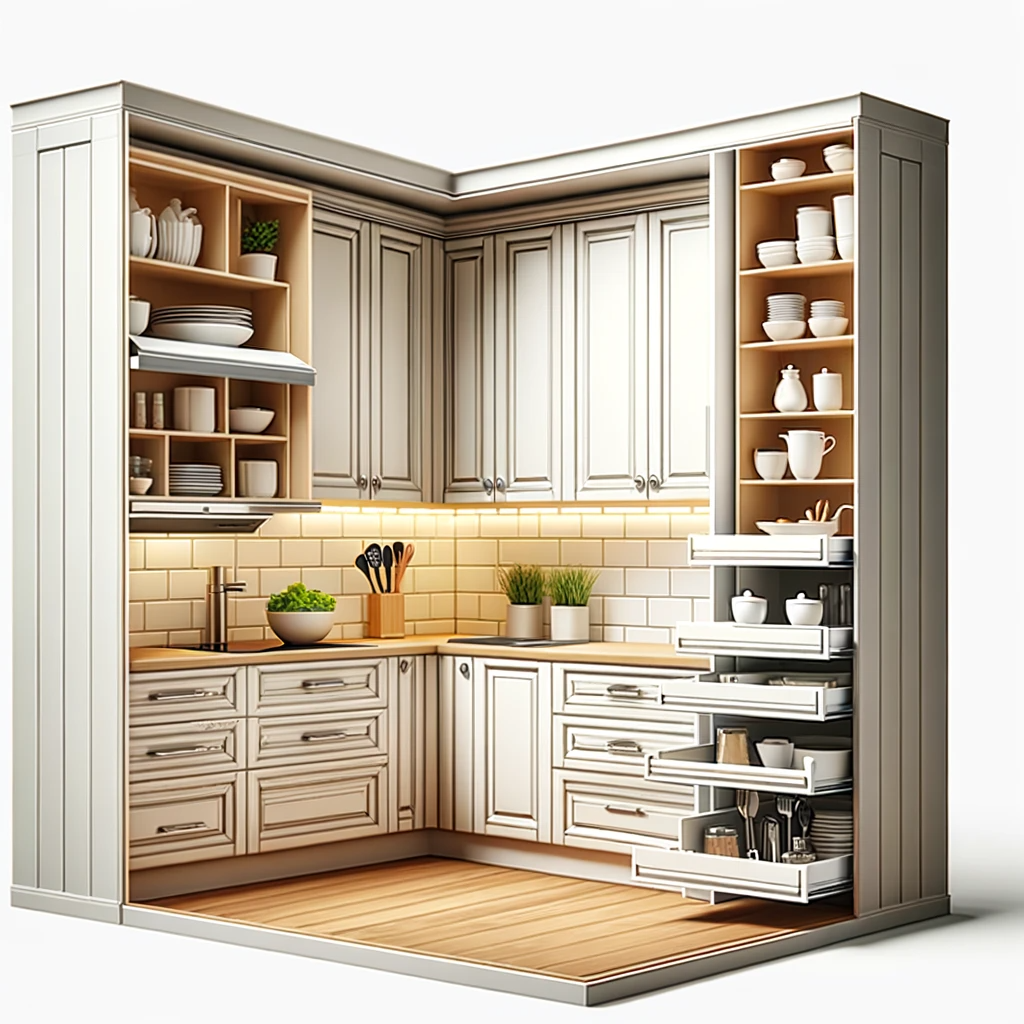
After
The kitchen’s storage capacity was significantly increased by implementing custom-sized, taller wall cabinets and innovative corner solutions; a pull-out pantry and under-cabinet storage for utensils were added, optimizing the limited space without cluttering it. Using lighter finishes on the cabinets created the illusion of a larger area, making the kitchen more open and inviting.
Case 2
Before
a spacious kitchen with outdated cabinetry that didn’t reflect the home’s traditional Javanese architecture.
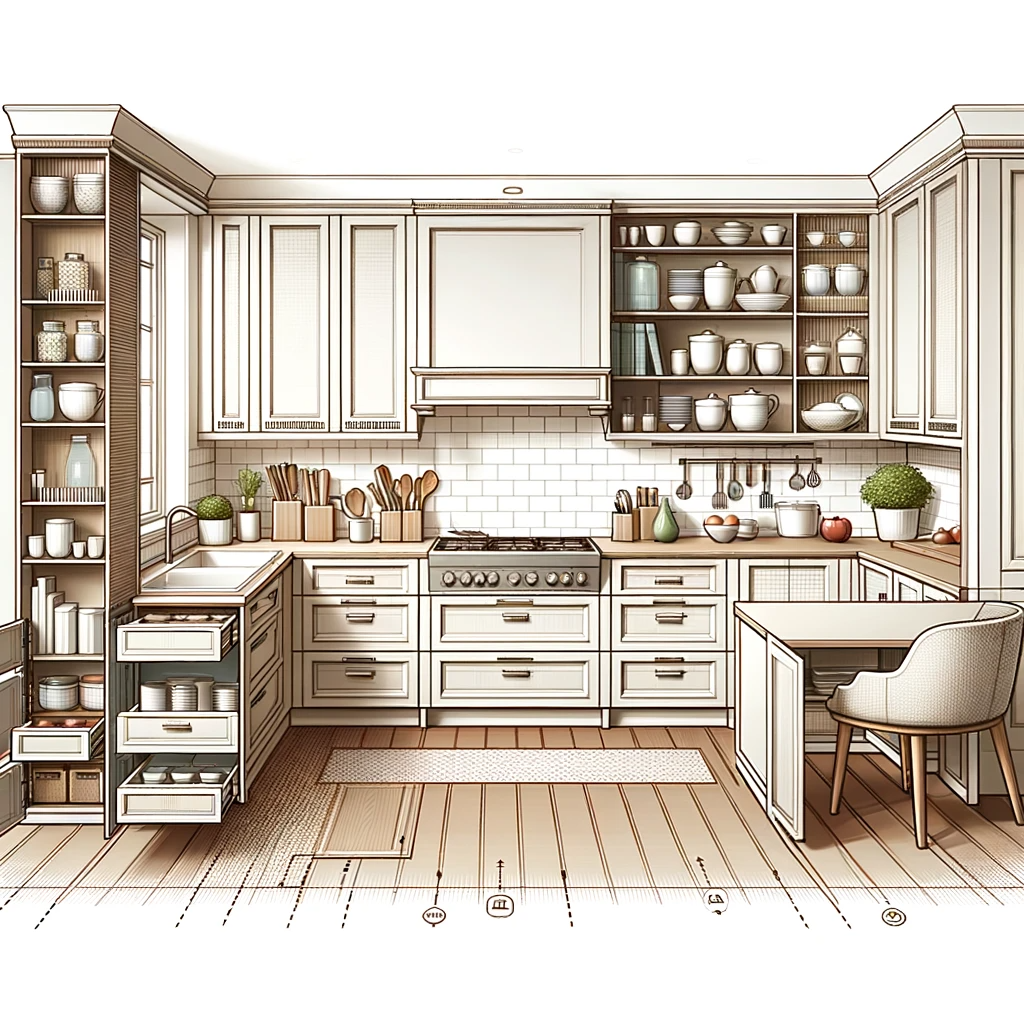
After
The renovation included custom cabinets made of MDF; the kitchen cabinet dimensions were expanded to better utilize the spacious kitchen area, providing ample storage and workspace. Modern ergonomic considerations, such as varying counter heights to accommodate different family members and pull-out shelves for easy access, were integrated.
Case 3
Before
A villa kitchen with a standard layout lacked the tropical, airy feel of its Balinese surroundings

After
The cabinets were redesigned with open shelving and glass fronts to create a more relaxed, airy feel. Materials resistant to humidity, like MDF, were used to ensure durability in the tropical climate. Adding a central island with a built-in sink improved functionality, providing a primary space for food preparation and social interaction.
These real-world examples demonstrate how well-planned kitchen cabinet dimensions and thoughtful design can transform Indonesian kitchens, enhancing their functionality and aesthetic appeal. Each case study reflects the unique blend of modern design principles with traditional Indonesian elements, catering to the specific needs and styles of the homeowners.
Conclusion and Invitation
In summary, selecting the correct kitchen cabinet dimensions transcends mere functionality. It’s about creating a space that perfectly aligns with your lifestyle, reflects your personal style, and respects the unique architectural spirit of Indonesian homes. Consideration of not just the size but also the material, finish, and your kitchen cabinets design must be balanced, especially in Indonesian homes’ diverse and dynamic context.
As you contemplate the perfect kitchen cabinets design, remember that it’s a deeply personal space—a reflection of your tastes, cooking habits, and way of life. Whether embracing the rich traditions of Indonesian design or forging a new path with modern minimalist cabinets, your choices will shape the heart of your home.
We invite you to contact us if you seek guidance or are ready to bring your dream kitchen to life. Our PA Kitchen & Furniture team is dedicated to helping you navigate these options, ensuring your kitchen is functional beautiful, and embodies your unique vision. Contact us to explore how we can transform your kitchen into a space that resonates with you, blending practicality with the beauty of Indonesian design.
Frequently Asked Questions
In compact apartments, base cabinets with a height of 85–90 cm and a reduced depth of around 50 cm can be more suitable, maximizing space without compromising usability.
To enhance storage without sacrificing style, consider adding multi-layered drawer organizers, pull-out spice racks, and corner units that maximize unused spaces. Sleek, handle-less cabinet doors with push-to-open mechanisms can also maintain a modern, streamlined look.
Materials like MDF, which are resistant to humidity, are advisable. They offer durability and are less likely to warp or degrade in tropical conditions.
Innovative features for modern kitchens include soft-close hinges, integrated LED lighting inside cabinets for better visibility, built-in charging stations for devices, and customizable drawer dividers for tailored organization. These features add functionality while keeping the design contemporary and user-friendly.
Using lighter finishes on cabinets and incorporating features like glass-front doors can create the illusion of more space. Also, optimizing vertical space with taller cabinets can make the kitchen feel more expansive.

